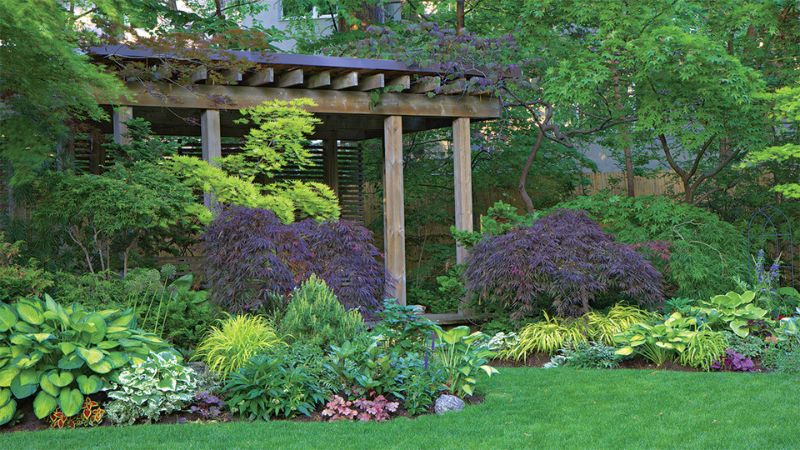Creating a beautiful shade garden is a rewarding challenge for any gardening enthusiast. Shade gardens, often considered tricky due to limited sunlight, can be transformed into lush, vibrant spaces with the right selection of plants. The key is to choose species that thrive in low-light conditions while adding both color and texture to your garden. Here are eight plants that will make your shade garden a standout oasis.
1. Hostas: The Foliage Superstar

Hostas are perhaps the most popular shade-loving plants, known for their lush foliage and incredible variety. Their leaves come in shades of green, blue, yellow, and even variegated patterns, offering a spectrum of colors that can brighten any dim corner. Hostas range from small to very large, making them versatile for different garden spaces.
Why Hostas?
- Versatile: With over 3,000 varieties, there’s a hosta for every garden.
- Low Maintenance: They require minimal care once established.
- Attractive Foliage: The large, textured leaves are visually striking.
2. Astilbes: The Colorful Plumes
Astilbes are renowned for their feathery plumes of flowers that bloom in shades of pink, red, white, and purple. These perennials thrive in moist, shaded areas and can add a pop of color to your garden during the summer months.
Why Astilbes?
- Vibrant Blooms: Their flowers can brighten up even the shadiest spots.
- Long Bloom Period: Astilbes bloom for several weeks, providing lasting color.
- Varied Heights: They come in different sizes, suitable for various garden layers.
3. Heucheras: The Shimmering Jewels
Heucheras, also known as coral bells, are prized for their stunning, ruffled leaves that come in a dazzling array of colors including deep purples, bright reds, and metallic silvers. These plants are not only visually appealing but also resilient and adaptable.
Why Heucheras?
- Striking Foliage: The foliage offers year-round interest.
- Diverse Colors: Available in a wide range of shades, adding depth to your garden palette.
- Compact Size: Ideal for borders, containers, and small garden spaces.
4. Ferns: The Classic Elegance

Ferns are the epitome of elegance in a shade garden, with their delicate, arching fronds adding a graceful touch to any landscape. They thrive in moist, shaded environments and can be used to create a lush, woodland feel.
Why Ferns?
- Timeless Beauty: Their classic look complements any garden style.
- Variety of Species: From the tiny maidenhair fern to the tall ostrich fern, there’s a fern for every spot.
- Low Maintenance: Once established, ferns require minimal care.
5. Bleeding Hearts: The Romantic Touch
Bleeding hearts are known for their heart-shaped flowers that dangle gracefully from arching stems. These plants bloom in shades of pink, red, and white, adding a romantic and whimsical element to any shade garden.
Why Bleeding Hearts?
- Unique Flowers: The distinctive, heart-shaped blooms are a garden highlight.
- Early Bloomers: They flower in early spring, bringing early color to your garden.
- Adaptability: They do well in partial to full shade.
6. Japanese Forest Grass: The Graceful Groundcover
Japanese forest grass (Hakonechloa macra) is a shade-loving ornamental grass that brings movement and texture to your garden. Its cascading, bamboo-like foliage ranges in color from bright green to golden yellow, depending on the variety.
Why Japanese Forest Grass?
- Graceful Movement: The arching leaves sway gently, adding a dynamic element.
- Seasonal Color Change: Some varieties change color with the seasons, providing year-round interest.
- Texture: Its fine texture contrasts beautifully with broader-leaved plants.
7. Toad Lilies: The Exotic Bloomers
Toad lilies (Tricyrtis) are exotic-looking perennials that produce small, orchid-like flowers in late summer to fall. They are perfect for adding unexpected color and intrigue to shady areas.
Why Toad Lilies?
- Unique Flowers: Their intricate, speckled blooms are a conversation starter.
- Late Bloomers: They provide color when many other plants have finished blooming.
- Shade Tolerant: They thrive in the deepest shade, adding beauty to hard-to-plant areas.
8. Lungwort: The Versatile Beauty

Lungwort (Pulmonaria) is a hardy perennial that offers both attractive foliage and charming flowers. The leaves are often spotted or variegated, while the flowers bloom in shades of blue, pink, or white, often changing color as they age.
Why Lungwort?
- Dual Appeal: Both the flowers and the foliage are visually appealing.
- Early Blooms: One of the first perennials to flower in spring.
- Ground Cover: Spreads well to cover bare spots under trees and shrubs.
Designing Your Shade Garden
When planning your shade garden, consider layering plants based on their height and texture. Place taller plants like hostas and ferns towards the back, with mid-sized plants such as astilbes and heucheras in the middle, and shorter groundcovers like Japanese forest grass and lungwort at the front. This creates a tiered effect that adds depth and interest.
Tips for Success
- Soil Preparation: Ensure your soil is rich in organic matter to support healthy growth.
- Watering: Most shade plants prefer consistent moisture; be sure to water them regularly.
- Mulching: Use mulch to retain moisture and suppress weeds.
- Fertilizing: Feed your plants with a balanced fertilizer in early spring to encourage robust growth.
Conclusion
Transforming a shady corner of your garden into a vibrant and textured oasis is entirely achievable with the right plant choices. By incorporating these eight shade-loving plants, you can create a stunning landscape that is as colorful as it is serene. Whether you prefer the lush foliage of hostas, the elegant fronds of ferns, or the exotic blooms of toad lilies, there’s a perfect plant for every part of your shade garden. Happy gardening!

